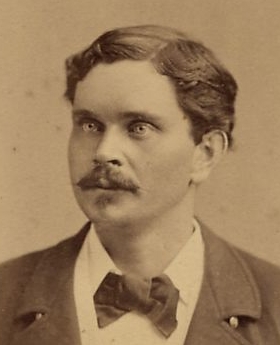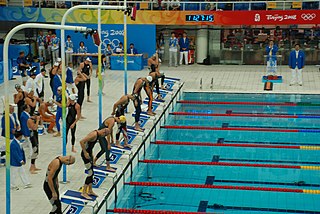
Captain Matthew Webb (1848–1883) was an English seaman, swimmer and stuntman who became the first person to swim the English Channel without the use of artificial aids. Webb increased the popularity of swimming in England.

The butterfly is a swimming stroke swum on the chest, with both arms moving symmetrically, accompanied by the butterfly kick along with the movement of the hips and chest. It is the newest swimming style swum in competition, first swum in the early 1930s and originating out of the breaststroke.

Annette Marie Sarah Kellermann was an Australian professional swimmer, vaudeville star, film actress, and writer, usually known as Annette Kellerman.

Paul Boyton, known as the Fearless Frogman, was a showman and adventurer some credit as having spurred worldwide interest in water sports as a hobby, particularly open-water swimming. Boyton is best known for his water stunts that captivated the world, including crossing the English Channel in a novel rubber suit that functioned similarly to a kayak. As the founder of Sea Lion Park in 1895, Boyton is also known as the originator of the first modern amusement park with a fenced-in enclosure and admission charged at the gate.

Clara "Clare" Dennis, later known by her married name Clare Golding, was an Australian breaststroke swimmer of the 1930s who won the gold medal in the 200-metre breaststroke at the 1932 Summer Olympics in Los Angeles, California.

Cecil Patrick Healy was an Australian freestyle swimmer of the 1900s and 1910s, who won silver in the 100 m freestyle at the 1912 Summer Olympics in Stockholm. He also won gold in the 4 × 200 m freestyle relay. He was killed in the First World War at the Somme during an attack on a German trench. Healy was the second swimmer behind Frederick Lane to represent Australia in Swimming and has been allocated the number "2" by Swimming Australia on a list of all Australians who have represented Australia at an Open International Level.

The men's 200 metre freestyle event at the 2000 Summer Olympics took place on 17–18 September at the Sydney International Aquatic Centre in Sydney, Australia. There were 51 competitors from 44 nations, with each nation having up to two swimmers.
Desmond Robert Renford MBE was an Australian long-distance swimmer who swam the English Channel 19 times from 19 attempts. This was a record for successful crossings by an Australian until it was overtaken by Chloe McCardel in 2016. From 1975 to 1979 and for a period in 1980 he held the title of King of the Channel. At the time of his death, only two other people had swum the Channel more often, Alison Streeter and Michael Read.

Richmond Cavill "Dick" Eve was an Australian diver who competed in the 1924 Summer Olympics. He won the gold medal in the plain high diving and finished fifth in the 3 metre springboard event. He was the first Australian Olympic diver to win a gold medal.

Marathon swimming is a class of open water swimming defined by long distances, with 10 kilometers being the unofficially held minimum distance. Routes are typically geographically based or buoy based. Geographical routes include crossings of channels and lakes, circumnavigations of islands, and stretches of coast lines or rivers. Buoy-routes are mainly found in competition events.

Swimming is an individual or team racing sport that requires the use of one's entire body to move through water. The sport takes place in pools or open water. Competitive swimming is one of the most popular Olympic sports, with varied distance events in butterfly, backstroke, breaststroke, freestyle, and individual medley. In addition to these individual events, four swimmers can take part in either a freestyle or medley relay. A medley relay consists of four swimmers who will each swim a different stroke, ordered as backstroke, breaststroke, butterfly and freestyle.

The front crawl or forward crawl, also known as the Australian crawl or American crawl, is a swimming stroke usually regarded as the fastest of the four front primary strokes. As such, the front crawl stroke is almost universally used during a freestyle swimming competition, and hence freestyle is used metonymically for the front crawl. It is one of two long axis strokes, the other one being the backstroke. Unlike the backstroke, the breaststroke, and the butterfly stroke, the front crawl is not regulated by the FINA. Hence, in "freestyle" competitive swimming events, any stroke or combination of strokes is permissible. This style is sometimes referred to as the Australian crawl although this can sometimes refer to a more specific variant of front crawl.

Freestyle is a category of swimming competition, defined by the rules of World Aquatics, in which competitors are subject to only a few limited restrictions on their swimming stroke. Freestyle races are the most common of all swimming competitions, with distances beginning with 50 meters and reaching 1,500 meters, also known as the mile. The term 'freestyle stroke' is sometimes used as a synonym for 'front crawl', as front crawl is the fastest surface swimming stroke. It is now the most common stroke used in freestyle competitions.

Swimming has been recorded since prehistoric times; the earliest recording of swimming dates back to Stone Age paintings from around 7,000 years ago. In 1578, Nikolaus Wynmann, a German professor of languages, wrote the first swimming book.

Wylie's Baths is a heritage-listed tidal swimming pool located near Coogee Beach, in the Eastern Suburbs of Sydney, New South Wales, Australia. The baths are noted for holding the first Australian Swimming Championships and for being one of the first swimming baths for mixed gender swimming in Australia. The Baths were added to the New South Wales State Heritage Register on 14 November 2003 and are also classified by the National Trust of Australia.
Joseph Nuttall was an accomplished English swimmer in the 1880s and 1890s, and into the early 1900s. He was the amateur English 100-yard and 220-yard champion from 1886 to 1888. He later turned professional and was generally the fastest professional of his period.

Frederick Edward Beckwith was an English swimmer who won "championship" races in the 1850s, despite only being a "passable" swimmer according to some accounts, and went on to become a popular "professor" and coach of swimming. He backed Matthew Webb to swim the channel and later managed his family members' swimming careers.
James Sydney Wallace Eve, MBE was an Australian sports administrator and former Honorary Secretary-Treasurer of the Australian Olympic Federation and Australian Brititish Empire & Commonwealth Games Association.

Alick F. Wickham was a Solomon Islander swimmer and diver. Wickham resided in Sydney from 1901 to 1927 where he achieved several Australian and New South Wales titles for swimming. Yet perhaps Wickham's most significant achievement is his 62-meter swan dive into the Yarra River, Melbourne in 1918 in which he was credited with breaking a world diving record and attracted more than 70,000 spectators from all across Melbourne. Wickham is also widely known for being a pioneer of the modern front crawl.
















